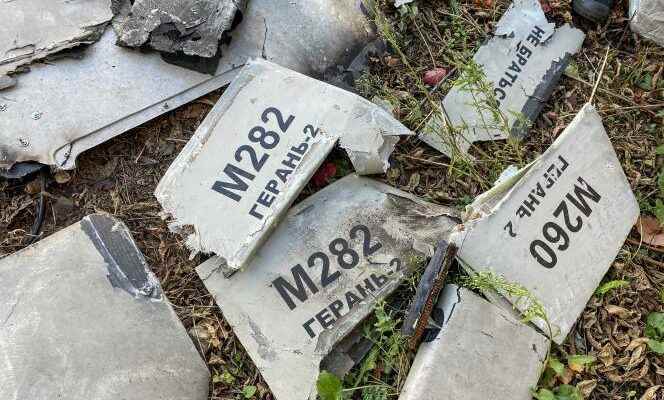They are called “Shahed-136” and are Vladimir Putin’s secret weapons. Yet they are also the “sign of his weakness”estimated Jens Stoltenbergthe Secretary General of the North Atlantic Treaty Organization, NATO, Tuesday 11 October.
The day before, drones supplied by Iran were used by Russia – in addition to missiles – to bomb kyiv, Lviv, Ternopil, Zhytomyr, Dnipro Kremenchuk, Zaporizhia and Kharkiv, killing at least 11 and injuring 89. “Of the 84 Russian missiles fired against Ukraine, 43 were shot down. Of the 24 Russian drones, 13 were shot down”said Ukrainian President Volodymyr Zelensky. Vladimir Putin justified these bombardments “massive” by the attack on the Crimean Bridge.
This may just be the start. Tuesday, October 11, the Ukrainian intelligence servicesquoted by theUkrainskaya Pravdaannounce that 32 Shahed-136 drones (“witness”, in Persian) were deployed in Belarus the day before, and that 8 others should be delivered before October 14.
A cheap gun
The Shahed-136 is manufactured by Iran Aircraft Manufacturing Industrial Company or HESA. It looks like a delta wing which is 3.5 m long with a wingspan of 2.5 m, and weighs around 200 kg. Its nose contains an explosive charge as well as the optics necessary for a precision attack. Fired in bursts, drones can be launched from a truck and fly at more than 185 km/h. The Russian military renamed the device Geran-2 (geranium-2).
The Russians began using these drones in an attempt to stem the counter-offensive in the Kharkiv region, hitting Ukrainian artillery and armor positions, reports the wall street journal. They were then used in the attack which destroyed a Odessa administrative building, September 25. At the beginning of October, they targeted Bila Tserkva in the Kyiv region and one of them was reportedly shot.
In a report, on September 14, the British Ministry of Defense mentions the destruction of a Shahed-136 by the Ukrainians, near Kupiansk. The machine is described by the British services as a “kamikaze” drone with a range of 2,500 km.
伊朗Shahed-136在袭击敖德萨的一座建筑物 https://t.co/7c0uZdKHw4
On the chain Current TimeUkrainian soldiers evoke a machine equipped “of a two-stroke engine such as a boat, lawnmower or moped” who hears himself coming from afar. “These machines are primitive”, confirms Yuriy Ihnat, a spokesman for the air force command. According to the Ukrainians, this is a fairly cheap weapon due to its simplicity: they fly straight to their target, do not have expensive optics, it is easy to program the coordinates of the target and launch them .
“The enemy is trying to save their different types of missiles. Shaheds are much cheaper and the enemy can launch several at once”explained Sergey Bratchuk, a representative of the Odessa regional military administration.
An announced arrival
The use of these drones is not a surprise. Their arrival was announced by the Biden administration. During July, White House National Security Advisor Jake Sullivan, explained that Iran was going to train the Russians to use some of its devices. According CNN and NPRa Russian delegation went in June and July to Kashan airfield, south of Tehran, to attend a presentation of Shahed-191 and Shahed-129 drones.
Then at the end of August, the washington post and the wall street journal announced that Iran had shipped them to Russia. Four flights were reportedly madeeach carrying a hundred drones, of at least two types : kamikaze drones and surveillance and electronic warfare drones.
After initial trials, the washington post wrote that the Russians were not completely satisfied with Iranian drones, which did not prevent them from using them.
Used by Iran and its allies before Russia
The drones delivered to Russia are the same ones used by Houthi rebels in Yemen against oil installations in Saudi Arabia or the United Arab Emirates. Drones that Iran is also suspected of having used against an Israeli tanker, in Oman, in 2021 and in Iraqi Kurdistan, against positions of Iranian Kurdish opposition parties based in Iraq.
After these drone strikes in the port of Odessa, Ukraine decided to “significantly reduce” Iran’s diplomatic presence in the country, in retaliation for arms deliveries from Tehran to Russia.
kyiv calls for new anti-aircraft missiles
To counter these drones, Ukraine is calling for new weapons, because they cannot be shot down by the Stingers (portable surface-to-air missiles), supplied by the United States at the start of the war, which are not equipped with a night vision system.
Monday, Ruslan Stefanchukthe Speaker of the Ukrainian Parliament wrote to Congress leaders asking the United States to prioritize the delivery of Nasams (for Norwegian Advanced Surface to Air Missile System). These missiles manufactured by the American manufacturer Raytheon and the Norwegian Kongsberg are supposed to be able to intercept any flying object within a radius of about 25 km.
In late August, the Biden administration approved sending six Nasams to Ukraine, but none have yet been delivered. After a phone call with US President Joe Biden, Mr Zelensky said securing air defenses was his number one priority.
Productive conversation with @POTUS. Air defense is currently the number 1 priority in our defense cooperation. We… https://t.co/4WQZMrdzBK
For its part, Germany promised to deliver soon a ground-to-air battery Iris-T SLM: these missiles are also supposed to be able to shoot down a target within a radius of 25 km. According to Twitter accounts that follow the war in Ukraine, they would have been, on Monday, seen in Poland.
